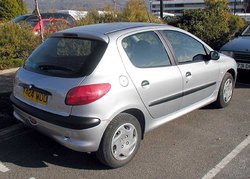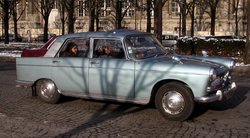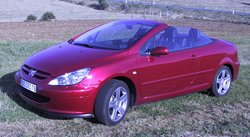Peugeot
|
|
Peugeot is a major French car manufacturer whose roots go back to bicycle manufacturing at the end of the 19th century. Peugeot became the largest bicycle manufacturer in France.
See Peugeot tuning.
| Contents |
Company History

Although the Peugeot factory had been in the manufacturing business for some time, their entry into the world of wheeled vehicles was by means of the bicycle. Armand Peugeot introduced the Peugeot "Le Grand Bi" penny-farthing in 1882 and a range of bicycles thereafter. Indeed, Peugeot bicycles have been built until very recently, although the car company and bike company parted ways in 1926.
Armand Peugeot became very interested in the automobile early on, and after meeting with Gottlieb Daimler and others was convinced of its viability. The first Peugeot automobile (a three-wheeled steam-powered car) was produced in 1889, in collaboration with Léon Serpollet. Steam power was heavy and bulky and required lengthy preparation before running, so it was soon abandoned in favor of the gasoline-fuelled internal combustion engine. 1890 saw the first such vehicle, powered by a Daimler engine and with four wheels.
Further cars followed, twenty-nine being built in 1892. Peugeot became the first manufacturer to fit rubber tires to a gasoline-powered car that year (solid tires; pneumatic would follow in 1895). The vehicles were still very much horseless carriages in appearance and were steered by tiller.
1896 saw the first Peugeot engines; no longer were they reliant on Daimler. Further improvements followed; the engine was soon under a hood (bonnet) at the front of the car, instead of hidden underneath, the steering wheel was adopted, and they began to look more like the modern car.
Peugeot added a motorcycle to its range in 1903, and motorcycles have been built under the Peugeot name ever since.
1913 saw a Peugeot driven by Jules Goux winning the Indianapolis 500. This car was powered by a Straight-4 engine designed by Ernest Henry, which had been successful in Grand Prix racing. This design was very influential for racing engines as it featured for the first time DOHC and 4 valves per cylinder providing for high engine speeds, a radical departure from previous racing engines which relied on sheer huge displacement for power. When one of the Peugeot racers remained in the United States during World War I and parts could not be acquired from France for the 1914 season, owner Bob Burma had it serviced in the shop of Harry Arminius Miller, by a young mechanic named Fred Offenhauser. Their familiarity with the Peugeot engine was the basis of the famed Miller racing engine, which later developed into the Offenhauser, or "Offy" racing engine.
By that year, Peugeot produced half of the cars built in France. 1916 and 1919 saw repeat wins at Indianapolis.
During the 1914-1918 years Peugeot turned largely to arms production, becoming a major manufacturer of arms and military vehicles, from bicycles to tanks and shells. Postwar, car production resumed in earnest; the car was becoming no longer just a plaything for the rich but accessible to many. 1926, however, saw the cycle (pedal and motor) business separate to form Cycles Peugeot -- the consistently profitable cycle division seeking to free itself from the rather more boom-and-bust auto business.
1929 saw the introduction of the Peugeot 201, the first car to be numbered in what became the Peugeot way -- three digits with a central zero, a registered Peugeot trademark. It was also the first mass-produced car with independent front suspension. Soon after, the Depression hit; Peugeot sales dived, but the company survived. In 1933, attempting a revival of fortune, the company unveiled a new, aerodynamically styled range; in the following year, a car with a folding, retractable hardtop was introduced, an idea revived by the Ford Skyliner in the 1950s and Mercedes recently.
The Second World War saw Peugeot's factories taken over for the German war effort, producing trucks and vans. The factories were heavily bombed.
1948 saw the company restarting in the car business, with the Peugeot 203. More models followed, many elegantly styled by the Italian design firm of Pininfarina. The company began selling cars in the United States in 1958. Like many European manufacturers, collaboration with other firms increased; Peugeot worked with Renault from 1966 and Volvo Cars from 1972.
In 1974 Peugeot bought a 30% share of Citroën, and took it over completely in 1976. Citroën enthusiasts complain that the company's legendary innovation and flair took a downturn with that acquisition. The joint parent company became the PSA (Peugeot Société Anonyme) group, keeping the separate identities of both brands but sharing engineering and technical resources.
The group took over the European division of Chrysler (which were formerly Rootes and Simca), in 1978 as the American auto manufacturer struggled to survive. The factories acquired were worn-out and the models outdated, and the resulting investments caused financial problems for the PSA group. From then on, the whole Chrysler/Simca range was sold under the Talbot badge until production of passenger cars was shelved in 1986. The Peugeot takeover of Chrysler Europe had seen the Chrysler Sunbeam, Horizon, Avenger and Alpine ranges rebadged as Talbots. There were also new Talbots in the early 1980's - the Solara (a saloon version of the Alpine hatchback), the Samba (a small hatchback to replace the Sunbeam) and the Tagora (a large saloon based on Peugeot 505 mechanicals).
1983 saw the launch of the popular and successful Peugeot 205, which is largely credited for turning things around. A large number of successful vehicles have followed.
US sales faltered, falling to just 4,261 405 and 505 models in 1990. The company's 2,240 sales through July, 1991 caused the company to pull the plug after 33 years.
Motor Sport
The company has had much success in international rallying, notably with the durable Peugeot 504, highly developed four-wheel-drive turbo-charged versions of the Peugeot 205, and more recently the Peugeot 206. Peugeot currently campaigns the Peugeot 307cc in the World Rally Championship. Peugeot won the grueling Paris Dakar Rally each year from 1987 to 1990.
In the 1990s the company raced at the Le Mans 24 Hours race, winning in 1992 and 1993.
The company has also been involved in providing engines to Formula One teams, notably Prost for the 1998, 1999 and 2000 seasons.
Peugeot Model Numbers
Peugeot names the models of their cars in the x0y format; x describes the size of the car (and hence its class), whereas y describes the model number (the higher the number, the newer the model). Therefore, a Peugeot 406 is bigger and newer than a Peugeot 305. This general rule has its exceptions, for instance the Peugeot 309 was produced before the Peugeot 306. Another exception is certain variants, such as the 206 SW, which is around the size of a 40y car.
This tradition began in 1929 with the launch of the 201. All numbers from 101 to 909 have been deposited as trademarks. Although in 1963 Porsche was forced to change the name of its new 901 coupé to 911, certain Ferraris and Bristols have been allowed to keep their Peugeot-style model numbers. An unsubstantiated explanation for the central '0' is that on early models the number appeared on a plate on the front of the car, with the hole for the starting handle coinciding with the zero. But the real first models, like the 301, 401 and 601, where not using this "trick". Only later models, like 302 and 402, have this feature. More recently, on the 307 CC and the 607 the button to open the trunk is located in the '0' of the label.
Peugeot is planning to use a four digit system in the future, with a double zero in the middle. It was tested with the 4002 concept car. The 1007 will be using this system when it is launched in 2005.
Peugeot has produced three winners of the European Car of the Year award.
- 1969: Peugeot 504
- 1988: Peugeot 405
- 2001: Peugeot 307
Other Peugeot models have come either second or third in the contest.
- 1980: Peugeot 505
- 1983: Peugeot 205
- 1996: Peugeot 406
- 1998: Peugeot 206
Other Products
Peugeot also makes pepper and salt grinders.
Pronunciation
The common French pronunciation of "Peugeot" is "POOzho" (IPA 'puːʒʊ). In British English, it is usually pronounced "PERzho" (IPA 'pɜːʒəʊ), while Americans often used "pooZHO" (IPA puː'ʒoʊ) instead. In some countries, "PYOOzho" ('pjuːʒoʊ) is encountered.
Vehicle models
Numbers
- 104, 106, 107
- 201, 202, 203, 204, 205, 206, 207
- 301, 302, 304, 305, 306, 307, 309
- 401, 402, 403, 404, 405, 406, 407
- 504, 505
- 601, 604, 605, 607
- 806, 807
- 905, 907
- 1007
- 4002
Others
A marque of the PSA Group | Peugeot timeline, 1950s–present (edit (https://academickids.com:443/encyclopedia/index.php?title=Template:Peugeot&action=edit)) | |||||||||||||||||||||||||||||||||||||||||||||||||||||||||||
| Type | 1950s | 1960s | 1970s | 1980s | 1990s | 2000s | ||||||||||||||||||||||||||||||||||||||||||||||||||||||
| 0 | 1 | 2 | 3 | 4 | 5 | 6 | 7 | 8 | 9 | 0 | 1 | 2 | 3 | 4 | 5 | 6 | 7 | 8 | 9 | 0 | 1 | 2 | 3 | 4 | 5 | 6 | 7 | 8 | 9 | 0 | 1 | 2 | 3 | 4 | 5 | 6 | 7 | 8 | 9 | 0 | 1 | 2 | 3 | 4 | 5 | 6 | 7 | 8 | 9 | 0 | 1 | 2 | 3 | 4 | 5 | 6 | 7 | 8 | 9 | |
| Mini | 104 | 106 | 107 | |||||||||||||||||||||||||||||||||||||||||||||||||||||||||
| Compact | 203 | 204 | 205 | 206 | 207 | |||||||||||||||||||||||||||||||||||||||||||||||||||||||
| 304 | 305 | 309 | 306 | 307 | ||||||||||||||||||||||||||||||||||||||||||||||||||||||||
| Midsize | 403 | 404 | 405 | 406 | 407 | |||||||||||||||||||||||||||||||||||||||||||||||||||||||
| Large | 504 | 505 | ||||||||||||||||||||||||||||||||||||||||||||||||||||||||||
| 604 | 605 | 607 | ||||||||||||||||||||||||||||||||||||||||||||||||||||||||||
| Minivan | 806 | 807 | ||||||||||||||||||||||||||||||||||||||||||||||||||||||||||
| Mini MPV | 1007 | |||||||||||||||||||||||||||||||||||||||||||||||||||||||||||
| SUV | 4007 | |||||||||||||||||||||||||||||||||||||||||||||||||||||||||||
See also
External link
- International Peugeot web site (http://www.peugeot.com)
- International Peugeot 807 Forum (http://www.eurovan2.com)cs:Peugeot
de:Peugeot es:Peugeot fr:Peugeot gl:Peugeot he:פג'ו ja:プジョー nl:Peugeot no:Peugeot pl:peugeot sv:Peugeot




